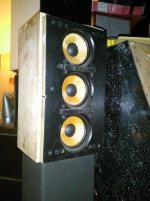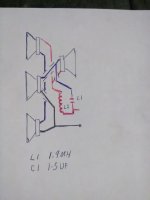Well CLD with a box within the box is quite difficult and uses a lot of volume. An idea I have. Instead of the butyl damping, stick some very heavy plates to the walls with a very soft foam inbetween. Seems to me like this should dampen the walls very wel. Kind of the same as CLD. Except it's not a sealed box in side a box. PMC did the same with the outer panels on their flagship Fenestria speaker.
Decoupling the driver could also work very well though I'm afraid of doing it in practice on my speakers. I can imagine mounting the midrange on a soft damping material could compromise it's transient response. Also, such a system would have to be tuned very well to make it work in your favor and not against you. I can imagine that such a system could also make the midrange lose transient impact/attack and make it sloppy. So I'm kind of scared to put this in my own speakers where I only have one shot at it.
 A box in a box is quite doable, with soft foam between the internal box ( or boxes ) and outer box.
A box in a box is quite doable, with soft foam between the internal box ( or boxes ) and outer box.I use Hawaphone for vibration Hawaphone, the sound insulation from Korff AG
and Twaron Angel Hair for volume damping 10-20g/liter https://www.eltim.eu/en/damping-material-etc/mundorf-angel-hair/g-10000062
Both are expensive but unsurpassed
and Twaron Angel Hair for volume damping 10-20g/liter https://www.eltim.eu/en/damping-material-etc/mundorf-angel-hair/g-10000062
Both are expensive but unsurpassed
Last edited:
If someone wants to use Hawaphon(e) make sure that you get it from a supplier for carpentry and not a DIY speaker supplier. There can be quite a difference in pricing !
Regards
Charles
Regards
Charles
Laurence Dickie also completely decouples his drivers in his designs using a tensioning rod on the back of the drivers and rubber gaskets. I imagine that extremely thin sorbothane would not effect the transient response in a bad way and more than likely would improve it.Well CLD with a box within the box is quite difficult and uses a lot of volume. An idea I have. Instead of the butyl damping, stick some very heavy plates to the walls with a very soft foam inbetween. Seems to me like this should dampen the walls very wel. Kind of the same as CLD. Except it's not a sealed box in side a box. PMC did the same with the outer panels on their flagship Fenestria speaker.
Decoupling the driver could also work very well though I'm afraid of doing it in practice on my speakers. I can imagine mounting the midrange on a soft damping material could compromise it's transient response. Also, such a system would have to be tuned very well to make it work in your favor and not against you. I can imagine that such a system could also make the midrange lose transient impact/attack and make it sloppy. So I'm kind of scared to put this in my own speakers where I only have one shot at it.

On my traffic light speakers I bolted the three front ( there's also on in the rear) drivers directly to the front baffle, however there are two square steel bars going from top to bottom on each side of the drivers ( for both weight and stiffness ) and the front baffle is held on by three tension springs against a cork gasket, which is also between the steel bars and front baffle for a damping effect. The stands are hollow to increase the volume.
HiVi Kevlar? i imagine cork would work well as a decoupler. Where are you low passing them at?
Last edited:
Some cheap Aiyima drivers from Amazon, glass fibre I think. The unconventional crossover is work in progress; I'm tempted to have some out of phase treble coming out the rear, and increasing the bass. I originally ran them all full range as a mini line array, but not for long...

HiVi Kevlar? i imagine cork would work well as a decoupler. Where are you low passing them at?
Sorry for the delay in response, the above image is the " crossover ", I think that the 1.9 mh choke has too much resistance because they sound a bit soft, unfortunately because the speaker is crammed full of drivers it would be impossible to have an iron core away from the magnets, I may have to have a choke in the stand. All four drivers are the same, with 6 ohm dc impedance, if I remember correctly. The values were just tuned by ear.
Last edited:
In my build I poured 10mm of levelling concrete on all inner surfaces, instead of adding pure water I mixed a third of wood glue and glass fibres, really sturdy, cabinets are dead silent,
Added weight is 25 kilo
Added weight is 25 kilo
Last edited:
- Home
- Loudspeakers
- Multi-Way
- Best compound to dampen enclosure?